Three-Dimensional Physical and Optical Characteristics of Aerosols over Central China from Long-Term CALIPSO and HYSPLIT Data
Abstract
:1. Introduction
2. Materials and Methods
2.1. Satellite Data
2.2. HYSPLIT Model
2.3. Principle and Methods
3. Results
3.1. Macroscopic Properties of Aerosols
3.2. Optical Properties of Aerosols
3.3. Physical Properties of Aerosols
3.4. Changes of Aerosol Vertical Distributions and Aerosol Sources
4. Discussion
5. Conclusions
- (1)
- An annual average of approximately 60% of aerosols distributed over central China mainly originated from local areas, whereas non-locally produced aerosols constituted approximately 40%. Anthropogenic polluted aerosols contributed 69.0% of aerosols, which mainly distributed below 2.0 km. Natural aerosols accounted for a small portion of the total amount of aerosols, and usually existed at an altitude higher than that of anthropogenic aerosols.
- (2)
- AGD was approximately 0.2–1.2 km, and the mean column AOD was approximately 0.49. The annual mean anthropogenic AOD and natural AOD were 0.34 and 0.15, respectively. IAB, CR, and DR were approximately 0.002, 0.82, and 0.14, respectively. Most of the aerosol particles distributed in the near surface were smaller and more spherical than those distributed above 2 km.
- (3)
- AOD and DR detected by CALIPSO displayed decreasing trends, with a total decrease of 0.11 and 0.016, respectively. These phenomena indicate that the extinction properties of aerosols decreased, and the degree of sphericity in aerosol particles increased during this study period. The trend of CR is not distinct, which possibly indicates that the size of the aerosol particles did not distinctly change. Moreover, the annual anthropogenic AOD and natural AOD demonstrated decreasing trends, with a total decrease of 0.07 and 0.04, respectively.
Acknowledgments
Author Contributions
Conflicts of Interest
Abbreviations
| AOD | aerosol optical depth |
| MODIS | Moderate Resolution Imaging Spectroradiometer |
| CALIPSO | Cloud–Aerosol Lidar and Infrared Pathfinder Satellite Observations |
| HYSPLIT | hybrid single-particle Lagrangian integrated trajectory |
| IAB | integrated attenuated backscatter |
| NCEP | National Center for Environmental Prediction |
| AGD | aerosol geometrical depth |
| CR | integrated particulate color ratio |
| DR | integrated 532 nm particulate depolarization ratio |
References
- Huang, J.; Minnis, P.; Lin, B.; Wang, T.; Yi, Y.; Hu, Y.; Sun-Mack, S.; Ayers, K. Possible influences of Asian dust aerosols on cloud properties and radiative forcing observed from MODIS and CERES. Geophys. Res. Lett. 2006, 33, 272–288. [Google Scholar] [CrossRef]
- Mao, F.; Duan, M.; Min, Q.; Gong, W.; Pan, Z.; Liu, G. Investigating the impact of haze on MODIS cloud detection. J. Geophys. Res. Atmos. 2016, 120, 12237–12247. [Google Scholar] [CrossRef]
- Guo, J.; Deng, M.; Lee, S.S.; Wang, F.; Li, Z.; Zhai, P.; Liu, H.; Lv, W.; Yao, W.; Li, X. Delaying precipitation and lightning by air pollution over the Pearl River Delta. Part I: Observational analyses. J. Geophys. Res. Atmos. 2016, 121, 6472–6488. [Google Scholar] [CrossRef]
- Mace, G.G.; Benson, S.; Kato, S. Cloud radiative forcing at the Atmospheric Radiation Measurement Program Climate Research Facility: 2. Vertical redistribution of radiant energy by clouds. J. Geophys. Res. Atmos. 2006, 111, 1937–1952. [Google Scholar] [CrossRef]
- Thorsen, T.J.; Fu, Q. CALIPSO-inferred aerosol direct radiative effects: Bias estimates using ground-based Raman lidars. J. Geophys. Res. Atmos. 2016, 120, 12209–12220. [Google Scholar] [CrossRef]
- Li, S.; Joseph, E.; Min, Q.; Yin, B.; Sakai, R.; Payne, M.K. Remote sensing of PM2.5 during cloudy and nighttime periods using ceilometer backscatter. Atmos. Meas. Tech. 2017, 10, 1–21. [Google Scholar] [CrossRef]
- Zhang, M.; Wang, L.; Gong, W.; Ma, Y.; Liu, B. Aerosol optical properties and direct radiative effects over central China. Remote Sens. 2017, 9, 997. [Google Scholar] [CrossRef]
- Wang, W.; Mao, F.; Du, L.; Pan, Z.; Gong, W.; Fang, S. Deriving Hourly PM2.5 Concentrations from Himawari-8 AODs over Beijing–Tianjin–Hebei in China. Remote Sens. 2017, 9, 858. [Google Scholar] [CrossRef]
- Wang, L.; Gong, W.; Xia, X.; Zhu, J.; Li, J.; Zhu, Z. Long-term observations of aerosol optical properties at Wuhan, an urban site in Central China. Atmos. Environ. 2015, 101, 94–102. [Google Scholar] [CrossRef]
- Kim, M.; Zhang, X.; Holt, J.B.; Liu, Y. Spatio-Temporal Variations in the Associations between Hourly PM2.5 and Aerosol Optical Depth (AOD) from MODIS Sensors on Terra and Aqua. Health 2013, 5, 8–13. [Google Scholar] [CrossRef] [PubMed]
- Qu, W.; Wang, J.; Zhang, X.; Sheng, L.; Wang, W. Opposite seasonality of the aerosol optical depth and the surface particulate matter concentration over the North China Plain. Atmos. Environ. 2015, 127, 90–99. [Google Scholar] [CrossRef]
- Yin, B.; Min, Q. Climatology of aerosol and cloud optical properties at the Atmospheric Radiation Measurements Climate Research Facility Barrow and Atqasuk sites. J. Geophys. Res. Atmos. 2014, 119, 1820–1834. [Google Scholar] [CrossRef]
- Huang, J.; Liu, J.; Chen, B.; Nasiri, S.L. Detection of anthropogenic dust using CALIPSO lidar measurements. Atmos. Chem. Phys. 2015, 15, 10163–10198. [Google Scholar] [CrossRef]
- Zhao, S.; Yu, Y.; Xia, D.; Yin, D.; He, J.; Liu, N.; Li, F. Urban particle size distributions during two contrasting dust events originating from Taklimakan and Gobi Deserts. Environ. Pollut. 2015, 207, 107–122. [Google Scholar] [CrossRef] [PubMed]
- Li, R. Multi-Satellite Observation of an Intense Dust Event over Southwestern China. Aerosol Air Qual. Res. 2015, 15, 263–270. [Google Scholar] [CrossRef]
- Tao, S.Y. A review of recent research on the East Asian summer monsoon in China. In Monsoon Meteorology; Chang, C.-P., Krishnamurti, T.N., Eds.; Oxford Univ. Press: New York, NY, USA, 1987; pp. 60–92. [Google Scholar]
- Winker, D.M.; Pelon, J.; Coakley, J.A.; Ackerman, S.A.; Charlson, R.J.; Colarco, P.R.; Flamant, P.; Fu, Q.; Hoff, R.M.; Kittaka, C. The CALIPSO Mission: A Global 3D View of Aerosols and Clouds. Bull. Am. Meteorol. Soc. 2010, 91, 1211–1229. [Google Scholar] [CrossRef]
- Pan, Z.; Mao, F.; Gong, W.; Min, Q.; Wang, W. The warming of Tibetan Plateau enhanced by 3D variation of low-level clouds during daytime. Remote Sens. Environ. 2017, 198, 363–368. [Google Scholar] [CrossRef]
- Pan, Z.; Gong, W.; Mao, F.; Li, J.; Wang, W.; Li, C.; Min, Q. Macrophysical and optical properties of clouds over East Asia measured by CALIPSO. J. Geophys. Res. Atmos. 2015, 120, 11653–11668. [Google Scholar] [CrossRef]
- Omar, A.H.; Winker, D.M.; Kittaka, C.; Vaughan, M.A.; Liu, Z.; Hu, Y.; Trepte, C.R.; Rogers, R.R.; Ferrare, R.A.; Lee, K.P. The CALIPSO Automated Aerosol Classification and Lidar Ratio Selection Algorithm. J. Atmos. Ocean. Technol. 2009, 26, 1994–2014. [Google Scholar] [CrossRef]
- Tian, P.; Cao, X.; Zhang, L.; Sun, N.; Sun, L.; Logan, T.; Shi, J.; Wang, Y.; Ji, Y.; Lin, Y. Aerosol vertical distribution and optical properties over China from long-term satellite and ground-based remote sensing. Atmos. Chem. Phys. 2017, 17, 1–47. [Google Scholar] [CrossRef]
- Winker, D.M.; Tackett, J.L.; Getzewich, B.J.; Liu, Z.; Vaughan, M.A.; Rogers, R.R. The global 3-D distribution of tropospheric aerosols as characterized by CALIOP. Atmos. Chem. Phys. 2012, 12, 24847–24893. [Google Scholar] [CrossRef]
- Mielonen, T.; Arola, A.; Komppula, M.; Kukkonen, J.; Koskinen, J.; De Leeuw, G.; Lehtinen, K.E.J. Comparison of CALIOP level 2 aerosol subtypes to aerosol types derived from AERONET inversion data. Geophys. Res. Lett. 2009, 36, 252–260. [Google Scholar] [CrossRef]
- Geng, F.; Liu, Q.; Chen, Y.; Hua, Z.; Mao, X. Preliminary Study of Vertical Distribution of Aerosols during Dry Haze Periods around Shanghai Based on CALIPSO. Procedia Earth Planet. Sci. 2011, 2, 217–222. [Google Scholar] [CrossRef]
- Yu, H.; Chin, M.; Winker, D.M.; Omar, A.H.; Liu, Z.; Kittaka, C.; Diehl, T. Global view of aerosol vertical distributions from CALIPSO lidar measurements and GOCART simulations: Regional and seasonal variations. J. Geophys. Res. Atmos. 2010, 115, 1307–1314. [Google Scholar] [CrossRef]
- Draxler, R.R.; Hess, G.D.; Draxler, R.R. An overview of the HYSPLIT-4 modelling system for trajectories. Aust. Meteorol. Mag. 1998, 47, 295–308. [Google Scholar]
- Freitag, S.; Clarke, A.D.; Howell, S.G.; Kapustin, V.N.; Campos, T.; Brekhovskikh, V.L.; Zhou, J. Combining airborne gas and aerosol measurements with HYSPLIT: A visualization tool for simultaneous evaluation of air mass history and back trajectory consistency. Atmos. Meas. Tech. 2014, 7, 107–128. [Google Scholar] [CrossRef] [Green Version]
- Huang, X.F.; He, L.Y.; Xue, L.; Sun, T.L.; Zeng, L.W.; Gong, Z.H.; Hu, M.; Zhu, T. Highly time-resolved chemical characterization of atmospheric fine particles during 2010 Shanghai World Expo. Atmos. Chem. Phys. 2012, 12, 1093–1115. [Google Scholar] [CrossRef]
- Badarinath, K.V.S.; Kharol, S.K.; Kaskaoutis, D.G.; Sharma, A.R.; Ramaswamy, V.; Kambezidis, H.D. Long-range transport of dust aerosols over the Arabian Sea and Indian region—A case study using satellite data and ground-based measurements. Glob. Planet. Chang. 2010, 72, 164–181. [Google Scholar] [CrossRef]
- Guo, J.; Liu, H.; Wang, F.; Huang, J.; Xia, F.; Lou, M.; Wu, Y.; Jiang, J.H.; Xie, T.; Zhaxi, Y. Three-dimensional structure of aerosol in China: A perspective from multi-satellite observations. Atmos. Res. 2016, 178–179, 580–589. [Google Scholar] [CrossRef]
- Che, H.; Zhang, X.; Chen, H.; Damiri, B.; Goloub, P.; Li, Z.; Zhang, X.; Wei, Y.; Zhou, H.; Dong, F. Instrument calibration and aerosol optical depth validation of the China Aerosol Remote Sensing Network. J. Geophys. Res. 2009, 114, 1065–1066. [Google Scholar] [CrossRef]
- Ma, X.; Bartlett, K.; Harmon, K.; Yu, F. Comparison of AOD between CALIPSO and MODIS: Significant differences over major dust and biomass burning regions. Atmos. Meas. Tech. 2013, 6, 2391–2401. [Google Scholar] [CrossRef]
- Burton, S.P.; Ferrare, R.A.; Vaughan, M.A.; Omar, A.H. Aerosol classification from airborne HSRL and comparisons with the CALIPSO vertical feature mask. Atmos. Meas. Tech. 2013, 12, 1397–1412. [Google Scholar] [CrossRef]
- Pérezramírez, D.; Lyamani, H.; Olmo, F.J.; Whiteman, D.N.; Aladosarboledas, L. Columnar aerosol properties from sun-and-star photometry: Statistical comparisons and day-to-night dynamic. Atmos. Chem. Phys. 2012, 12, 9719–9738. [Google Scholar] [CrossRef] [Green Version]
- Gao, L.; Tian, Y.; Zhang, C.; Shi, G.; Hao, H.; Zeng, F.; Shi, C.; Zhang, M.; Feng, Y.; Li, X. Local and long-range transport influences on PM2.5 at a cities-cluster in northern China, during summer 2008. Particuology 2014, 13, 66–72. [Google Scholar] [CrossRef]
- Zhang, W.; Zhuang, G.; Guo, J.; Xu, D.; Wang, W.; Baumgardner, D.; Wu, Z.; Yang, W. Sources of aerosol as determined from elemental composition and size distributions in Beijing. Atmos. Res. 2010, 95, 197–209. [Google Scholar] [CrossRef]
- Zheng, S.; Yi, H.; Li, H. The impacts of provincial energy and environmental policies on air pollution control in China. Renew. Sustain. Energy Rev. 2015, 49, 386–394. [Google Scholar] [CrossRef]
- Guo, J. Observation of an agricultural biomass burning in central and east China using merged aerosol optical depth data from multiple satellite missions. Int. J. Remote Sens. 2014, 35, 5971–5983. [Google Scholar]
- Latif, M.T.; Huey, L.S.; Juneng, L. Variations of surface ozone concentration across the Klang Valley, Malaysia. Atmos. Environ. 2012, 61, 434–445. [Google Scholar] [CrossRef]
- Fernandoy, F.; Meyer, H.; Tonelli, M. Stable water isotopes of precipitation and firn cores from the northern Antarctic Peninsula region as a proxy for climate reconstruction. Cryosphere Discuss. 2012, 5, 313–330. [Google Scholar] [CrossRef] [Green Version]
- Zhang, Z.; Engling, G.; Lin, C.Y.; Chou, C.K.; Lung, S.C.C.; Chang, S.Y.; Fan, S.; Chan, C.Y.; Zhang, Y.H. Chemical speciation, transport and contribution of biomass burning smoke to ambient aerosol in Guangzhou, a mega city of China. Atmos. Environ. 2010, 44, 3187–3195. [Google Scholar] [CrossRef]
- Yang, Y.J.; Fu, Y.F.; Wu, B.W.; Shi, C.E.; Deng, X.L.; Zhang, H.; Zhang, Y. Impacts of agricultural fire on aerosol distribution over East China during summer harvest time. J. Atmos. Environ. Opt. 2013, 8, 5–16. [Google Scholar]
- Zhang, L.; Liao, H.; Li, J. Impacts of Asian summer monsoon on seasonal and interannual variations of aerosols over eastern China. J. Geophys. Res. Atmos. 2010, 115. [Google Scholar] [CrossRef]
- Zhang, F.; Cheng, H.R.; Wang, Z.W.; Lv, X.P.; Zhu, Z.M.; Zhang, G.; Wang, X.M. Fine particles (PM2.5) at a CAWNET background site in Central China: Chemical compositions, seasonal variations and regional pollution events. Atmos. Environ. 2014, 86, 193–202. [Google Scholar] [CrossRef]
- Deng, X.; Shi, C.; Wu, B.; Chen, Z.; Nie, S.; He, D.; Zhang, H. Analysis of aerosol characteristics and their relationships with meteorological parameters over Anhui province in China. Atmos. Res. 2012, 109–110, 52–63. [Google Scholar] [CrossRef]
- Li, S.; Joseph, E.; Min, Q.; Yin, B. Multi-year ground-based observations of aerosol-cloud interactions in the Mid-Atlantic of the United States. J. Quant. Spectrosc. Radiat. Transf. 2016, 188, 192–199. [Google Scholar] [CrossRef]
- Feng, Y.; Kotamarthi, V.R.; Coulter, R.; Zhao, C.; Cadeddu, M. Radiative and thermodynamic responses to aerosol extinction profiles during the pre-monsoon month over South Asia. Atmos. Chem. Phys. 2016, 16, 247–264. [Google Scholar] [CrossRef]
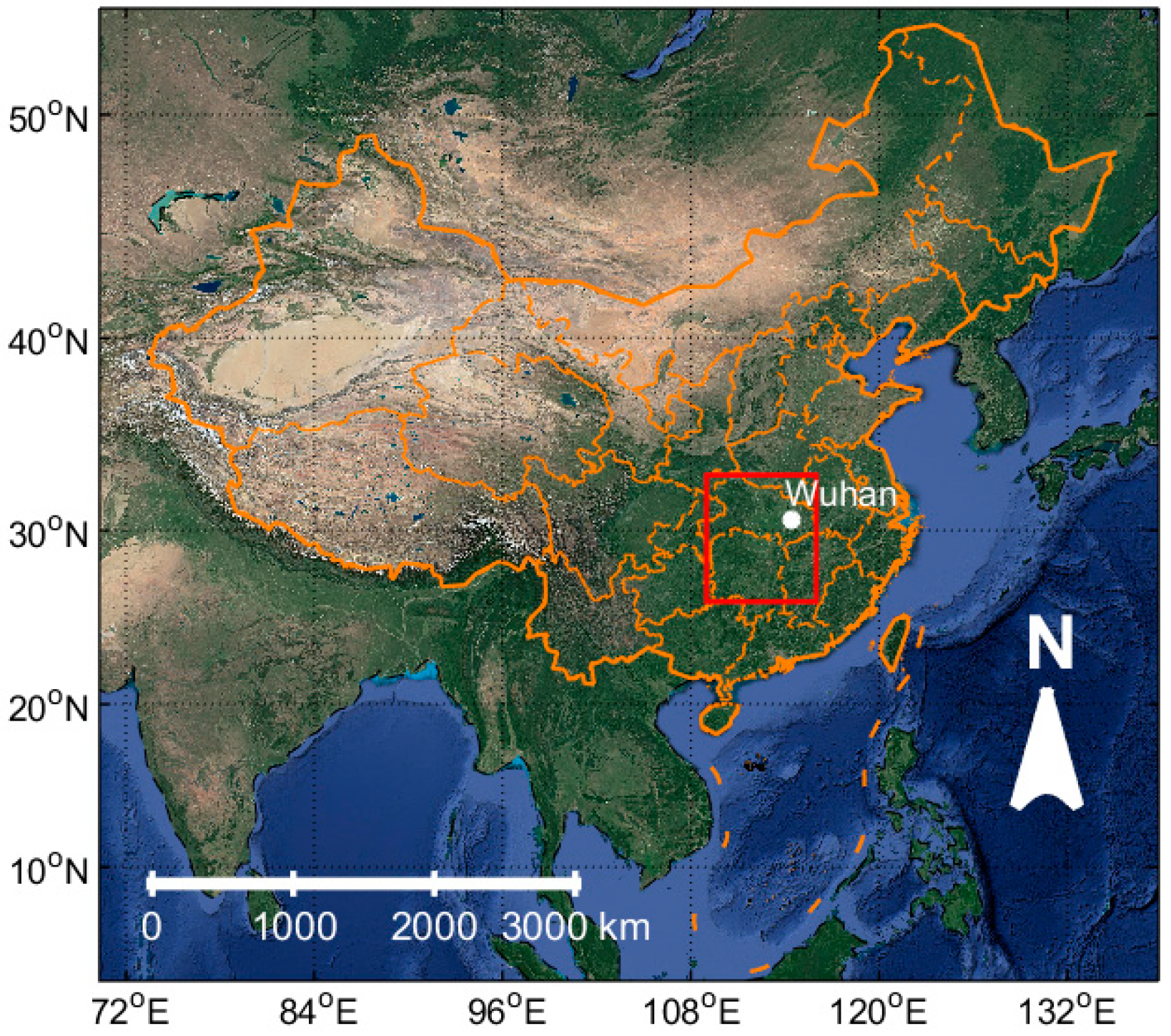
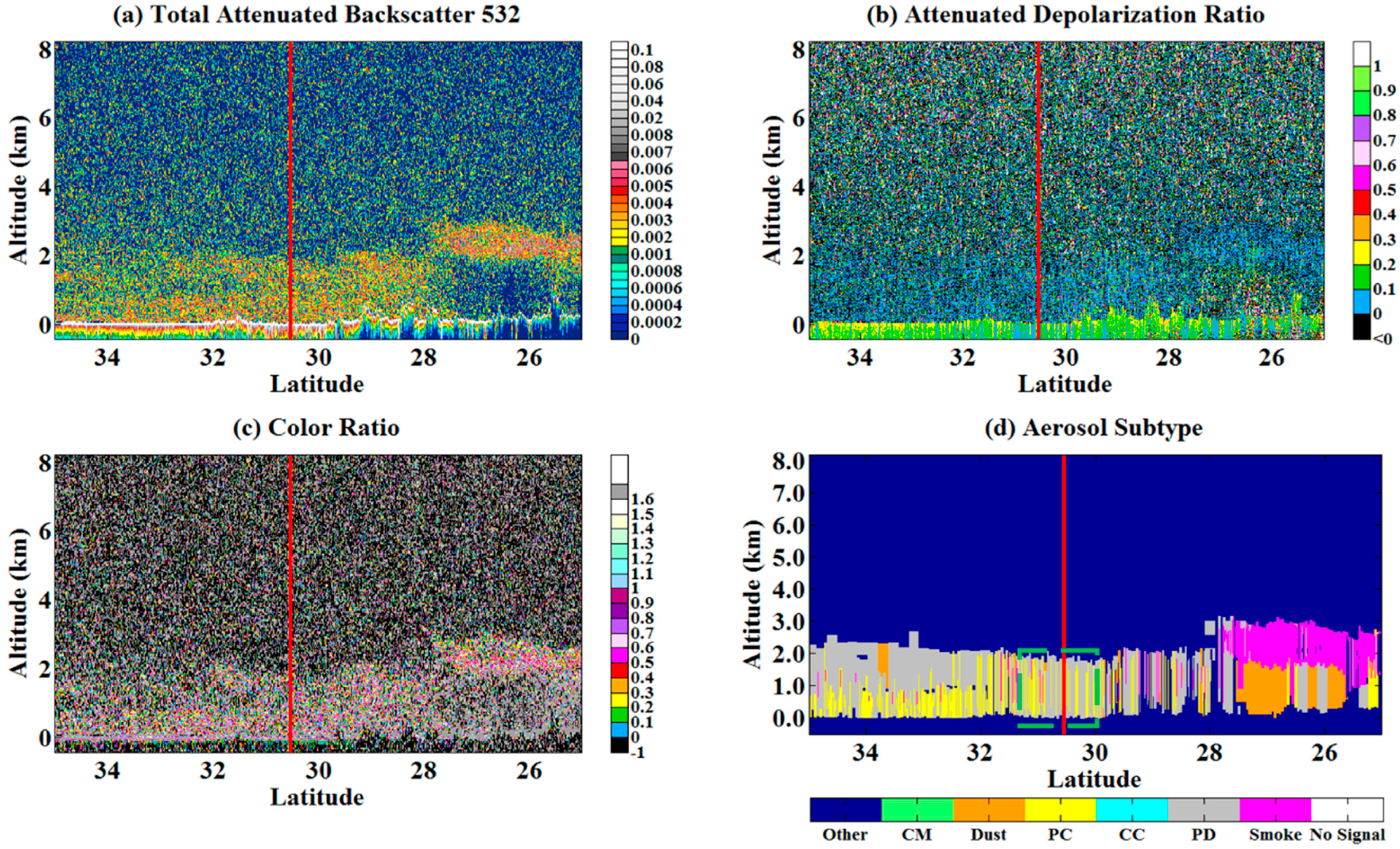
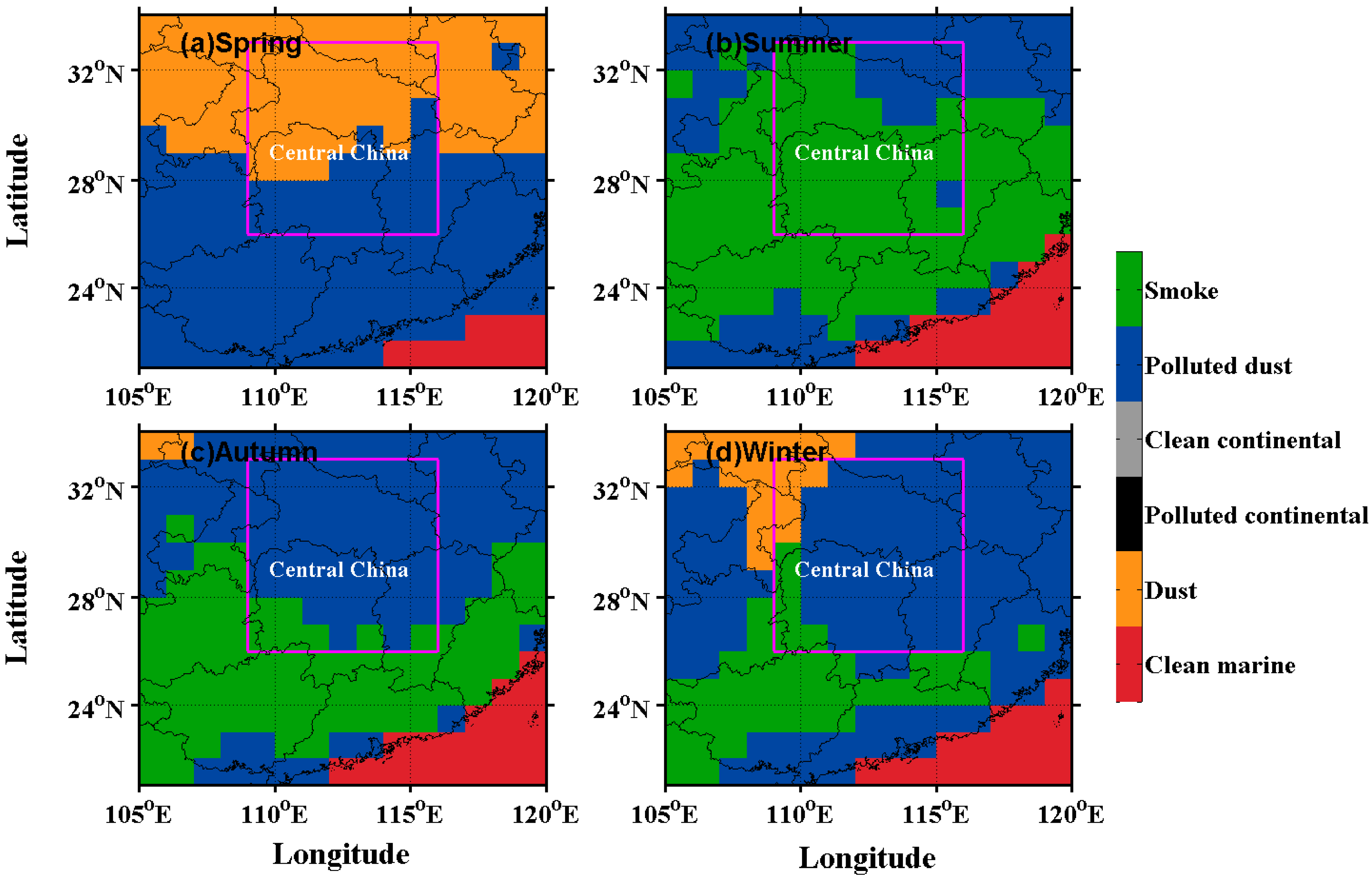


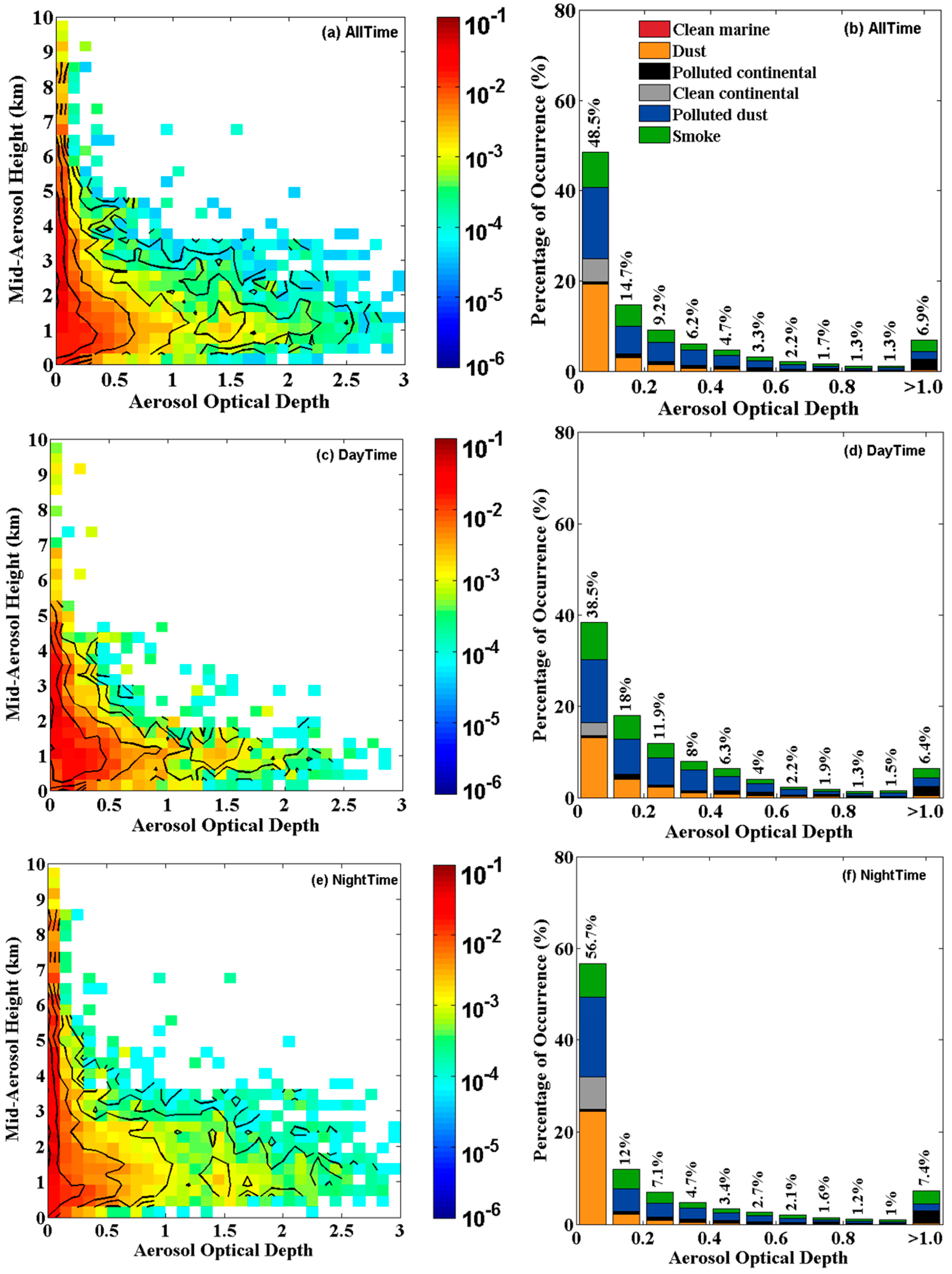




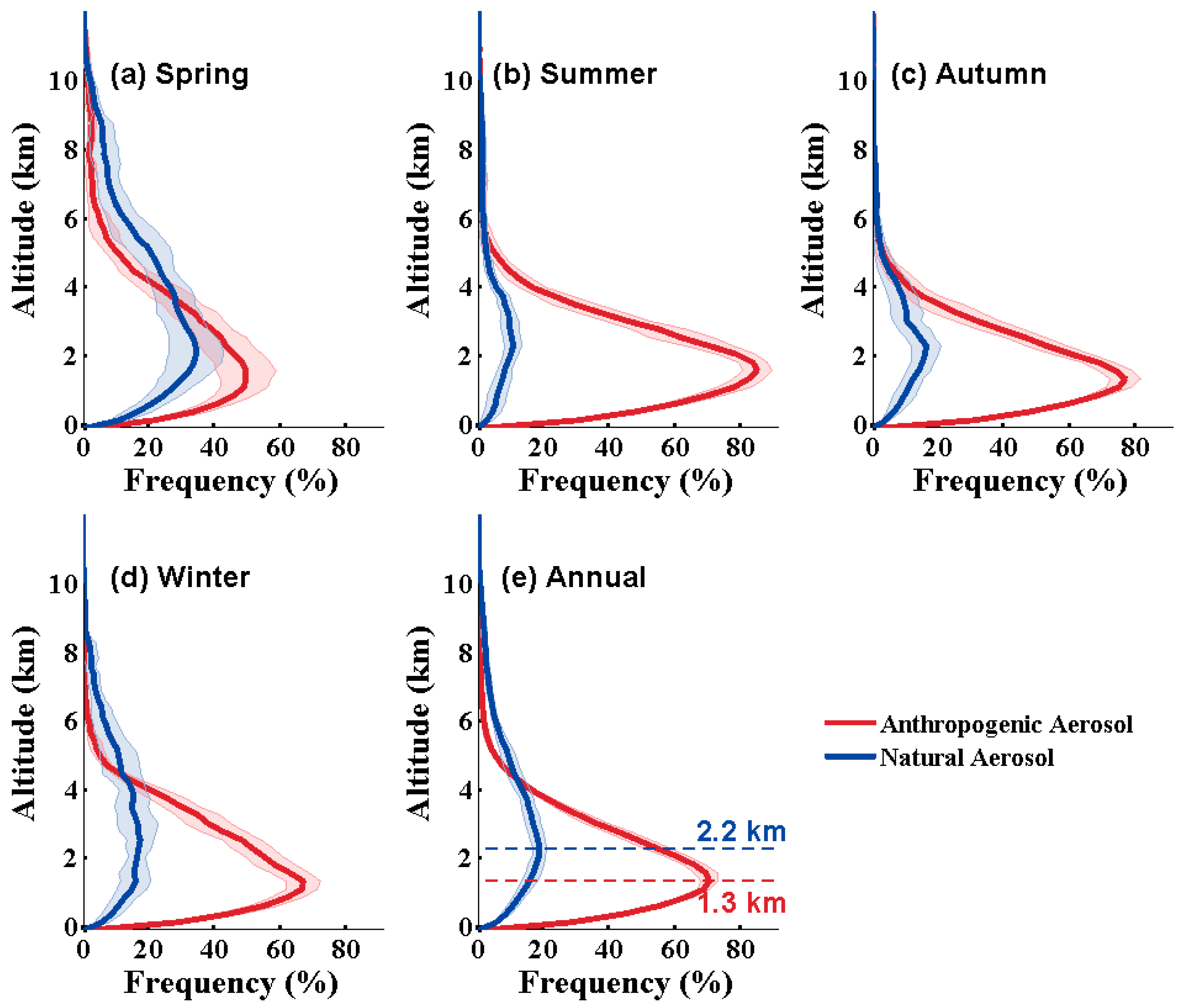
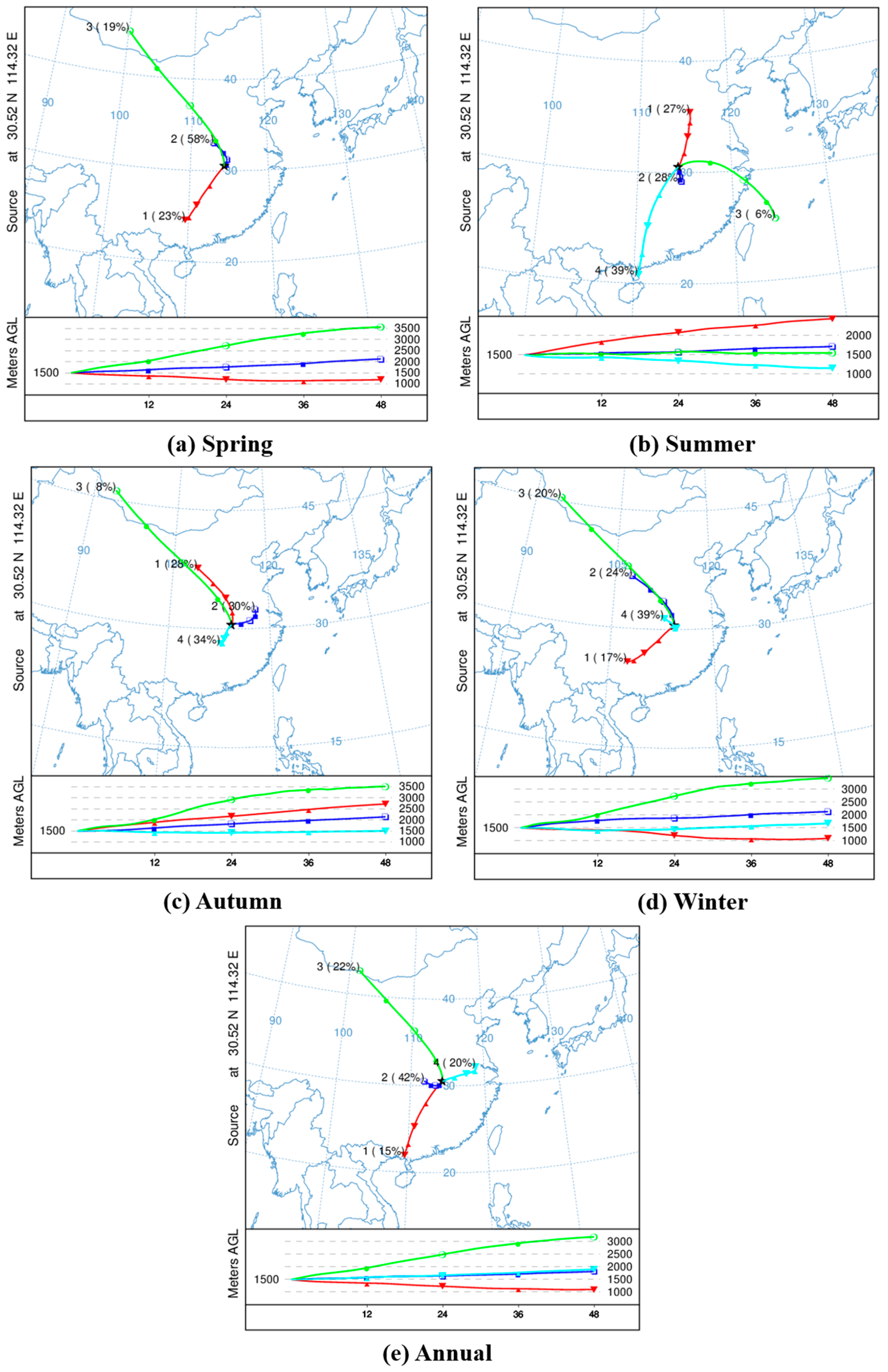
| Spring | Summer | Autumn | Winter | |
|---|---|---|---|---|
| Dust | 58.81 | 14.88 | 25.52 | 43.32 |
| Polluted continental | 8.44 | 22.03 | 20.46 | 15.78 |
| Clean continental | 5.29 | 14.98 | 10.41 | 6.28 |
| Polluted dust | 54.96 | 45.30 | 51.56 | 61.62 |
| Smoke | 20.89 | 50.89 | 38.12 | 33.19 |
| 0–0.1 | 0.1–0.2 | 0.2–0.3 | 0.3–0.4 | 0.4–0.5 | 0.5–0.6 | 0.6–0.7 | 0.7–0.8 | 0.8–0.9 | 0.9–1.0 | >1.0 | Total | |
|---|---|---|---|---|---|---|---|---|---|---|---|---|
| Dust | 19.3 | 3.0 | 1.5 | 0.7 | 0.4 | 0.2 | 0.1 | 0.2 | 0.1 | 0.3 | 25.8 | |
| Polluted continental | 0.5 | 0.9 | 0.6 | 0.7 | 0.7 | 0.6 | 0.4 | 0.4 | 0.3 | 0.3 | 2.4 | 7.8 |
| Clean continental | 5.2 | 5.2 | ||||||||||
| Polluted dust | 15.7 | 6.2 | 4.3 | 3.3 | 2.4 | 1.6 | 1.1 | 0.5 | 0.4 | 0.5 | 1.7 | 37.7 |
| Smoke | 7.8 | 4.6 | 2.8 | 1.5 | 1.2 | 0.9 | 0.6 | 0.6 | 0.5 | 0.5 | 2.5 | 23.5 |
| All Aerosol Types | 48.5 | 14.7 | 9.2 | 6.2 | 4.7 | 3.3 | 2.2 | 1.7 | 1.3 | 1.3 | 6.9 | 100 |
| Cluster in Red | Cluster in Blue | Cluster in Green | Cluster in Cyan | |
|---|---|---|---|---|
| Spring | 23% | 58% | 19% | |
| Summer | 27% | 28% | 6% | 39% |
| Autumn | 28% | 30% | 8% | 34% |
| Winter | 17% | 24% | 20% | 39% |
| Annual | 15% | 42% | 22% | 20% |
© 2018 by the authors. Licensee MDPI, Basel, Switzerland. This article is an open access article distributed under the terms and conditions of the Creative Commons Attribution (CC BY) license (http://creativecommons.org/licenses/by/4.0/).
Share and Cite
Lu, X.; Mao, F.; Pan, Z.; Gong, W.; Wang, W.; Tian, L.; Fang, S. Three-Dimensional Physical and Optical Characteristics of Aerosols over Central China from Long-Term CALIPSO and HYSPLIT Data. Remote Sens. 2018, 10, 314. https://doi.org/10.3390/rs10020314
Lu X, Mao F, Pan Z, Gong W, Wang W, Tian L, Fang S. Three-Dimensional Physical and Optical Characteristics of Aerosols over Central China from Long-Term CALIPSO and HYSPLIT Data. Remote Sensing. 2018; 10(2):314. https://doi.org/10.3390/rs10020314
Chicago/Turabian StyleLu, Xin, Feiyue Mao, Zengxin Pan, Wei Gong, Wei Wang, Liqiao Tian, and Shenghui Fang. 2018. "Three-Dimensional Physical and Optical Characteristics of Aerosols over Central China from Long-Term CALIPSO and HYSPLIT Data" Remote Sensing 10, no. 2: 314. https://doi.org/10.3390/rs10020314






